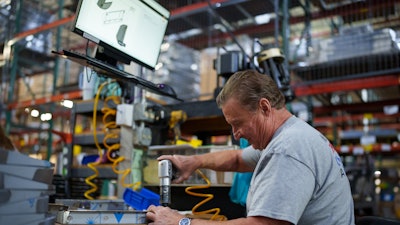
PICO MES, a software company enabling digital transformation for factories, has worked to modernize factory floor operations at Winston Industries.
Inside its Louisville, Kentucky facility, Winston Industries is relying on PICO MES’ digital worker guidance to enhance manufacturing productivity, employee training and retention for its multi-generational workforce.
The employees at Winston Industries are embracing new digital tools and a fresh series of work instructions and stations, contributing to a major workplace transformation. All workers, regardless of seniority or experience, are working with these innovative tools, driving the company's evolution.
In this interview, Shaun Tanner, president and CEO of Winston Industries, and Ryan Kuhlenbeck, co-founder and CEO of Pico MES, provide their perspectives on their partnership, workplace shifts, and the future of each company, respectively.
*****
Devon Verbsky: How did the partnership with PICO come to be?
Shaun Tanner: I created a plan five years ago with the initiative to find work instructions for every assembly area in the company. We began the full search process in 2021 and in 2022, we came across PICO.
I explained that I can’t have something that is words only, but photos, graphs, and demonstrations to intuitively understand as well. PICO created work instructions for every area on the production floor, from the small beginner stage to in-depth, advanced work.
DV: How has the workforce grown to accept this change?
ST: They loved it. I was not as worried about my younger generation. The older generation rather is somewhat anti-change—not just here, but in general, as the way you might have done things over and over again has always worked. But they’re embracing it, saying that it simply makes it easier for them to do their job. It has become so much easier to train new employees as they no longer have to learn individually from another person, saving time for both.
DV: How much time is being taken out of the training process?
ST: This is an assumption as it has not been fully broken down, but it used to take new hires about two months to get fully trained and integrated—fifty percent of that time is hands-on training with a coworker..
But now, within two to three weeks, new employees have fifty percent hands-on training for the first week, and then the next two weeks they are on their own with that tool. So, you are going from 60 days with two people, to 30 days with half a person.
DV: Have you seen a change in mistakes?
ST: We are still too early to tell. Historically, we take a look at warranty claims. That data comes in 12 to 18 months after production starts, so that data is not yet available. What I will say is we have a measurement called “first pass yield.” It’s a final quality check after the product makes it to the finish line.
That metric has seen a 10 percent increase in the last two years. I can’t say that’s 100 percent on PICO and the work instructions, but it’s making a tremendous difference.
DV: As an outsider coming in, seeing this advancement at Winston in the technology department, are workers more inclined to jump into a position like this?
ST: Absolutely. If you are a Gen-Z or Millennial, chances are good that you’ve had a perception that manufacturing facilities are rough spots you maybe wouldn’t want to be. That goes away when you see the technology at hand. It’s no longer an old, archaic system, but rather a place where workers can come in knowing they can accomplish what’s needed.
Additionally, if you are of an older generation coming in and being trained by someone younger, chances may be that it doesn’t go quite as well as planned. It goes a lot smoother when you are learning from a computer.
*****
Devon Verbsky: What was your side of the partnership with Winston like?
Ryan Kuhlenbeck: We found each other through a mutual tool partner. We came together rather quickly as they were looking for a plethora of different integration options. Over the course of two years, we’ve built up hundreds of processes within the system. Now, that does not look like much on the floor, but it’s intended to be that way to help them do their job. With Winston especially, it’s been neat to see how people can progress. We will of course watch in constant support for years to come, but we anticipate additional processes coming to life as we go.
DV: With the additions as you go, do you see yourself being the key player in the processing with Winston?
RK: Usually, and hopefully. A big problem we face in the industry is what we would call ‘dead ends.’ Two years ago, if you were buying work instructions, you’d like strictly digital instructions with no PowerPoint presentation type. Most companies cannot connect to tools, so you can get the instructions in place, but when it’s time to go error-proof, you need to be able to turn off a tool and turn on another, moving to the right settings and measuring good or bad.
If you have to then go in and integrate a whole new system to do that, it can be quite a burden. With PICO however, that exists, so they will be able to operate in that format. And if they wanted to connect to their ordering system so that product automatically comes to the shop floor, they could do that. And when they reach the limits of PICO, we have already built further integrations so they can get what they need for leverage such as artificial intelligence or advanced cameras, it can all work optimally for them.
Our stance on this is we want to give people access without forcing them to use something. Given that they are in a competitive industry, we have to go about ensuring that we are giving the right thing.
Anything we add to the PICO platform for one factory becomes available to every factory. So if we integrate a new tool or bring in a new feature of video display, or even connect the CAD mode to the system, they will be able to take advantage of that without having to go out of their way to pursue that individually.
DV: How many facilities do you work with?
RK: A few dozen at this point and growing pretty rapidly. They are scattered throughout the U.S. and we have a few overseas, heavy in the automotive industry, aerospace, as well as industrial equipment. Semiconductor equipment as well has become a big deal that we can work with.
DV: What separates PICO from other MES software companies?
RK: Affordability is a big key, and then the ease of use. Those two can be tied together as you make it affordable when you don’t have a ton of custom work that needs to be done. Technically, PICO has a lot of differences. From behind the scenes, we run a bottom-up MES rather than a top-down. Instead of starting with your high level factory routings and big picture from day one, you can start with one station, one process, and build up from there.
We have a free version at PICO, and that can be scaled all the way up to running full automotive OEM factories, but you can take advantage of whatever chunk you like. In the case of Winston Industries, they use the work instructions. Other factories are focused on tool connections. Some need advanced business system connections, but each factory can choose what they want.
DV: What are you pushing for next?
RK: For us, as you have these digital backbones, there is a digital thread coming off of each and every station. They know when an assembly went into a station, when it was produced, what operator produced it. But if you can take that data that each factory has, you can connect the supply chains to each other as well. And now that data can be shared, where a supplier can send data to the next and so on in the chain before it gets to the end product.
If you can see data across each of the suppliers, you can solve issues faster and improve your logistics. Rapid deployments in all of these factories means we can join them together. This factory has their solution, while the one across the street might still be using paper instructions. And the factory next to that might have a full robotics line, but is not connected. If you can connect them together then people can build applications on top of that data, enhancing efficiency.























